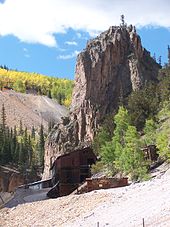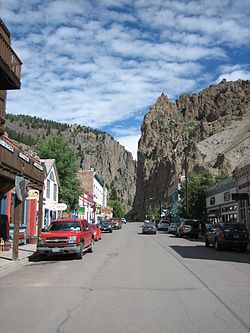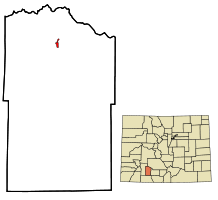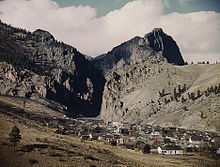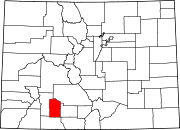- Creede, Colorado
-
Town of Creede, Colorado — Town — Downtown Creede Motto: There is no night in Creede! Location in Mineral County and the State of Colorado Coordinates: 37°50′58″N 106°55′34″W / 37.84944°N 106.92611°WCoordinates: 37°50′58″N 106°55′34″W / 37.84944°N 106.92611°W Country  United States
United StatesState  State of Colorado
State of ColoradoCounty Mineral County Seat[1] Incorporated May 19, 1892[2] Government - Type Statutory Town[1] Area - Total 0.6 sq mi (1.6 km2) - Land 0.6 sq mi (1.6 km2) - Water 0 sq mi (0 km2) Elevation[3] 8,799 ft (2,682 m) Population (2000) - Total 377 - Density 628.3/sq mi (235.6/km2) Time zone MST (UTC-7) - Summer (DST) MDT (UTC-6) ZIP Code[4] 81130 Area code(s) 719 FIPS code 08-17980 GNIS feature ID 0190444 Website City website The historic town of Creede is a Statutory Town that is the county seat of, and the only incorporated municipality in, Mineral County, Colorado, United States.[5] The town population was 377 at the U.S. Census 2000.
Contents
History
Travelers to this area appeared in the early 19th century. Tom Boggs, a brother-in-law of Kit Carson , farmed at Wagon Wheel Gap in the summer of 1840. The first silver discovery was made at the Alpha mine in 1869, but the silver could not be extracted at a profit from the complex ores. Ranchers and homesteaders moved in when stagecoach stations (linking the mining operations over the Divide with the east) were built in the 1870s, but the great “Boom Days” started with the discovery of rich minerals in Willow Creek Canyon in 1889.[citation needed]
Creede was the last silver boom town in Colorado in the 19th century. The town leapt from a population of 600 in 1889 to more than 10,000 people in December 1891. The Creede mines operated continuously from 1890 until 1985, and were served by the Denver & Rio Grande Railroad.[citation needed]
The original townsite of Creede was located on East Willow Creek just above its junction with West Willow Creek. Below Creede were Stringtown, Jimtown, and Amethyst. The Willow Creek site was soon renamed Creede after Nicholas C. Creede who discovered the Holy Moses Mine. Soon the entire town area from East Willow to Amethyst was called Creede.[citation needed]
At the same time that Creede was booming, the capital city of Denver, Colorado was experiencing a major legal reform movement against gambling clubs and saloons. Numerous owners of major gambling houses in Denver quickly relocated to Creede's business district. One of these relocators was the infamous confidence man, Jefferson Randolph "Soapy" Smith. Soapy became the uncrowned king of Creede's criminal underworld, and opened the Orleans Club. Other famous people in Creede were Robert Ford (the man who killed outlaw Jesse James), Bat Masterson, and William Sidney "Cap" Light (the first deputy sheriff in Creede, and brother-in-law of Soapy Smith). On June 5, 1892 a major fire destroyed most of the business district. Three days later, on June 8, Ed O'Kelley walked into Robert Ford's make-shift tent-saloon and shot him dead. The town of Creede was incorporated on June 13, 1892, but the anti-gambling reform movement in Denver had ceased, and the Denver businessmen moved back to their old stomping grounds.[citation needed]
Creede’s boom lasted until 1893, when the Silver Panic hit all of the silver mining towns in Colorado. The price of silver plummeted and most of the silver mines were closed. Creede never became a ghost town, although the boom was over and its population declined. After 1900, Creede stayed alive by relying increasingly on lead and zinc in the ores. Total production through 1966 was 58 million troy ounces (870 metric tons) of silver, 150 thousand ounces (4.7 metric tons) of gold, 112 thousand metric tons of lead, 34 thousand metric tons of zinc, and 2 million metric tons of copper.[6]
Geography
Creede is located at 37°50′58″N 106°55′34″W / 37.84944°N 106.92611°W (37.849311, -106.925983)[7] near the headwaters of the Rio Grande River, which flows through the San Juan Mountains and the San Luis Valley on its way to New Mexico, Texas, and eventually into the Gulf of Mexico.
The river has played a critical role in the development of farming and ranching in the Valley. The Rio Grande and its tributary trout streams provide excellent opportunities for fly fishermen and its unspoiled headwaters in the Weminuche Wilderness are a favorite for hikers.[citation needed]
According to the United States Census Bureau, the town has a total area of 0.6 square miles (1.6 km2), all of it land.
Demographics
Historical populations Census Pop. %± 1990 362 — 2000 377 4.1% Est. 2009 403 6.9% U.S. Decennial Census As of the census[8] of 2000, there were 377 people, 181 households, and 106 families residing in the town. The population density was 622.4 people per square mile (238.6/km²). There were 275 housing units at an average density of 454.0 per square mile (174.1/km²). The racial makeup of the town was 96.82% White, 1.33% Native American, and 1.86% from two or more races. Hispanic or Latino of any race were 1.59% of the population.
There were 181 households out of which 19.3% had children under the age of 18 living with them, 46.4% were married couples living together, 8.8% had a female householder with no husband present, and 41.4% were non-families. 33.1% of all households were made up of individuals and 12.2% had someone living alone who was 65 years of age or older. The average household size was 2.08 and the average family size was 2.70.
In the town the population was spread out with 19.1% under the age of 18, 5.0% from 18 to 24, 26.3% from 25 to 44, 33.7% from 45 to 64, and 15.9% who were 65 years of age or older. The median age was 45 years. For every 100 females there were 100.5 males. For every 100 females age 18 and over, there were 98.1 males.
The median income for a household in the town was $30,893, and the median income for a family was $34,125. Males had a median income of $27,250 versus $17,250 for females. The per capita income for the town was $21,801. About 12.2% of families and 13.4% of the population were below the poverty line, including 31.0% of those under age 18 and 11.1% of those age 65 or over.
Popular culture
In the 1976 film, "The Shootist", starring John Wayne as J.B. Books, a terminally ill gun fighter, Books, when being questioned about his symptoms by a trusted doctor friend relates that he had just seen a "sawbones" (a slang reference for a doctor or surgeon), in Creede. The trusted friend of Books, a Doctor Hostetler (played by Jimmy Stewart) then asks Books, "and what did my colleague in Creede say?"[citation needed]
See also
References
- ^ a b "Active Colorado Municipalities". State of Colorado, Department of Local Affairs. http://www.dola.state.co.us/dlg/local_governments/municipalities.html. Retrieved 2007-09-01.
- ^ "Colorado Municipal Incorporations". State of Colorado, Department of Personnel & Administration, Colorado State Archives. 2004-12-01. http://www.colorado.gov/dpa/doit/archives/muninc.html. Retrieved 2007-09-02.
- ^ "US Board on Geographic Names". United States Geological Survey. 2007-10-25. http://geonames.usgs.gov. Retrieved 2008-01-31.
- ^ "ZIP Code Lookup" (JavaScript/HTML). United States Postal Service. http://zip4.usps.com/zip4/citytown.jsp. Retrieved September 6, 2007.
- ^ "Find a County". National Association of Counties. http://www.naco.org/Counties/Pages/FindACounty.aspx. Retrieved 2011-06-07.
- ^ Henry C. Meeves and Richard P. Darnell (1968) Study of the Silver Potential, Creede District, Mineral County, Colorado, US Bureau of Mines, Information Circular 8370.
- ^ "US Gazetteer files: 2010, 2000, and 1990". United States Census Bureau. 2011-02-12. http://www.census.gov/geo/www/gazetteer/gazette.html. Retrieved 2011-04-23.
- ^ "American FactFinder". United States Census Bureau. http://factfinder.census.gov. Retrieved 2008-01-31.
External links
Municipalities and communities of Mineral County, Colorado County seat: Creede Town Creede
Unincorporated
communityCategories:- Populated places in Mineral County, Colorado
- Towns in Colorado
- County seats in Colorado
Wikimedia Foundation. 2010.

